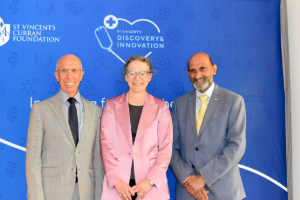
Richard, Anthony, my sincere congratulations on the launch of your campaign. I wish you every success.
Thank you for the opportunity to speak today on Gadigal Land. I wish to acknowledge the Traditional Custodians and pay my respects to their Elders past, present, and emerging.
I’m a nano scientist. That means I could place 21 lasers in one strand of your hair. Please don’t worry, I’m not going to attempt that today.
My discovery research over the past 30 years has led to the creation of new solar cells, new methods to split water to create clean energy sources, breath sensing for ketosis and using nanotechnology and AI to develop treatments for people with dementia.
My passion for supporting discovery research is something I think we all share.
If that weren’t the case, you wouldn’t be here today.
We also share a commitment to improving lives and making our nation a better place.
As well as my research, it is also my great privilege to lead Australia’s top scientists as the President of the Australian Academy of Science.
I’m sure many of you know some of our Fellows – our former President Professor John Shine AC from the Garvan and St Vincent’s precinct.
Our current Vice President and Council Member is clinician and researcher Professor Bob Graham AO – from the Victor Change Cardiac Research Institute and St Vincent’s Hospital. There are others, 600 in fact!
The Academy works every day to advance Australia as a nation that embraces scientific knowledge. And a nation whose people enjoy the benefits of science.
While the latter is certainly the case, Australia has a long way to go to truly embrace scientific knowledge.
Our Prime Minister has said that science is essential to future economic growth and could unlock our potential as a country.
Acknowledging the importance of science is one thing. Investing in science is another.
In the decade leading up to 2020, Australia’s investment in research and development declined to a new low point.
As government investment in R&D falls, the incentive for business investment falls with it.
It is perhaps no surprise that productivity growth was the slowest in 20 years over the same period.
It is clear there is a mismatch between Australia’s aspirations and its support for science.
We need science to decarbonise our industries and economy.
We need science to build defence capability that will strengthen national security.
We need science to take advantage of the opportunities AI and quantum technologies bring.
We need science to improve our health and turn discoveries into cures that are used in clinical practice here at St Vincent’s and beyond.
It is clear that science has never been more valuable. And yet with record low levels of investment, it has never been more vulnerable.
As the Academy works to reverse the decades-long decline in R&D investment, we see important roles for not just government but also industry, universities, the research sector and philanthropists.
We know investment in R&D is patient capital. It’s the long game. But dollars invested return in spades – both in economic wealth but also in our health and wellbeing which is priceless.
In fact, the Australian Research Council recently reported that for every research dollar invested via one of their major grant programs, the return is $3.32.
Failing to invest in discovery science is like constructing a building without foundations. It may last for a while, but if we get a big wind, then the building will come down.
Philanthropy especially has the potential to transform funding in the scientific landscape in this country and provide sustained investment.
In its quest to deliver the best healthcare and innovative medical research, the St Vincent’s Curran Foundation seeks to bridge government funding gaps through the generous support of others.
I support this approach too via my own personal endeavours. My wife, Vidya and I created a fund which gives students and researchers from developing countries a chance to travel to the Australian National University to pursue collaborative research and develop their networks.
We did this because we have directly felt the transformational impact that the generosity of others can have. If it weren’t for the generosity of my maths teacher in India, today I would be ploughing the field in India like my cousins.
Our own desire to create opportunities for others has inspired many around me, and I am so pleased that our family fund is helping several students each year.
I close by commending you all – as clinicians, researchers and philanthropists – for supporting science, discovery and research in Australia.
Your efforts go so much further than you can imagine.
Thank you.








